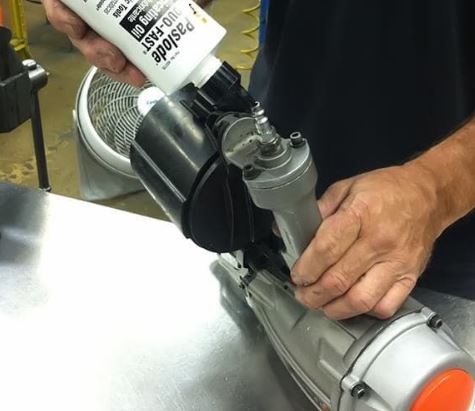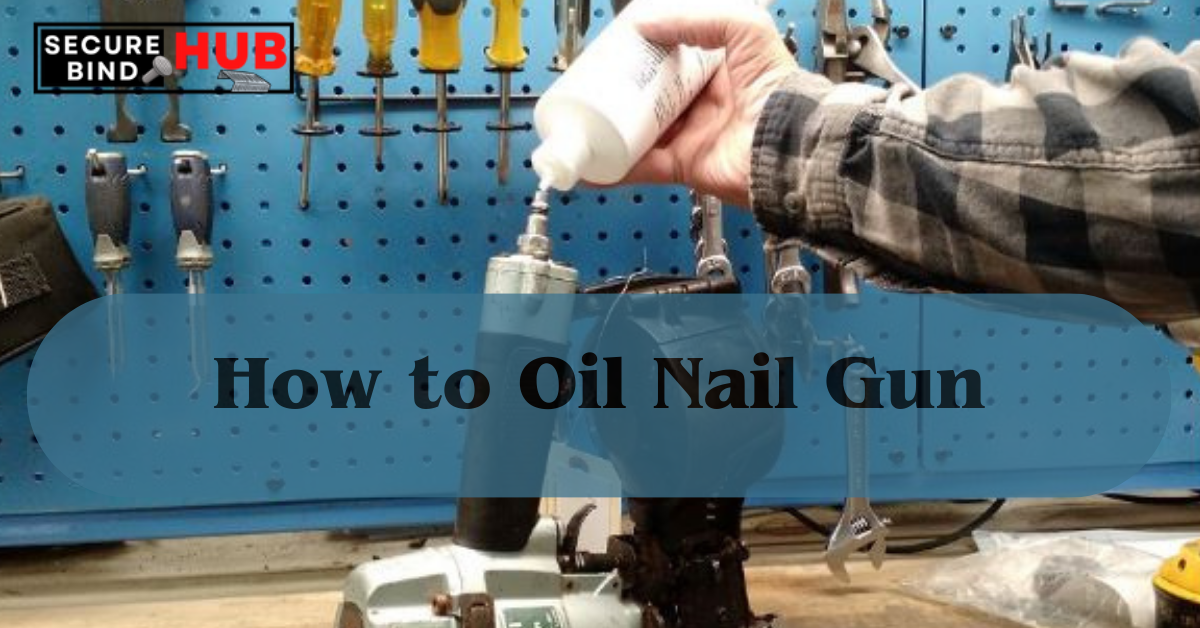If you’re a professional carpenter, mastering the art of using a nail gun is essential for efficient and precise woodworking. One crucial aspect of ensuring your nail gun functions smoothly and maintains its longevity is knowing how to oil it correctly. In this guide, we will walk you through the essential steps and tips on how to oil nail gun, ensuring that your tool remains in optimal working condition. Whether you’re a seasoned pro or just starting with nail guns, understanding this maintenance task is key to achieving professional results and avoiding potential issues down the road. So, let’s dive into the world of nail gun maintenance and learn how to oil your tool effectively.
Step-by-Step Oil Application

Now that you’ve chosen the right oil for your nail gun, it’s time to proceed with the oiling process. Follow these step-by-step instructions to ensure your nail gun receives proper lubrication:
- Safety First: Before you begin, ensure that your nail gun is disconnected from the air supply. Safety glasses and gloves are also recommended to protect your eyes and hands from any oil splatter or debris.
- Prepare Your Workspace: Find a clean and well-ventilated area to work in. Lay down a disposable cloth or newspaper to catch any drips or excess oil.
- Locate the Oil Ports: Check your nail gun’s user manual to locate the oil ports. These are typically found near the nail magazine or on the body of the tool. They may be labeled with a small oil can icon.
- Clean the Tool: Use a clean cloth or rag to wipe down the exterior of the nail gun, removing any dust, dirt, or debris. A clean tool will ensure that contaminants do not enter the internal components during the oiling process.
- Apply Oil: Take the selected pneumatic tool oil and carefully add a few drops into each oil port. Use the oiler nozzle or a small, clean funnel to avoid spills. Refer to your nail gun’s manual for the recommended amount of oil.
- Actuate the Trigger: To distribute the oil evenly through the internal components, repeatedly actuate the trigger of the nail gun without nails loaded in the magazine. This will help the oil spread throughout the tool.
- Inspect for Leaks: While actuating the trigger, check for any oil leaks or excess oil coming out of the exhaust port. If you notice excessive leakage, stop and consult your user manual or a professional for guidance.
- Wipe Excess Oil: After oiling, wipe away any excess oil from the exterior of the nail gun using a clean cloth. This helps prevent oil from attracting dust and debris during use.
- Reconnect Air Supply: Once you’re satisfied with the oil distribution, reconnect the nail gun to the air supply and perform a test firing to ensure it operates smoothly.
- Regular Maintenance: Make a note to oil your nail gun regularly, as recommended in your user manual. This frequency can vary depending on usage, so refer to the manufacturer’s guidelines for the best maintenance schedule.
By following these step-by-step instructions for oil application, you’ll help ensure that your nail gun remains in top working condition, performs efficiently, and enjoys a longer lifespan, making your woodworking projects a breeze to complete.
Troubleshooting
While properly oiling your nail gun can help prevent many issues, occasionally, problems may still arise during operation. Here are some common troubleshooting tips to address potential nail gun problems:
Misfires or Jams:
- Ensure you are using the correct nail size and type recommended for your nail gun.
- Check for bent or damaged nails in the magazine.
- Clean the nail magazine and remove any debris or dirt.
- Inspect the nosepiece for any obstructions or damage.
- Adjust the air pressure to the recommended level for your nail gun.
Air Leaks:
- Listen for hissing sounds, which may indicate air leaks.
- Check all pneumatic connections and hoses for loose or damaged parts.
- Tighten any loose fittings or replace damaged components.
Inconsistent Depth of Drive:
- Adjust the depth control on your nail gun to achieve the desired depth of drive.
- Ensure the air pressure is consistent and matches the manufacturer’s recommendations.
- Check for worn or damaged driver blades and replace them if necessary.
Nail Gun Won’t Fire:
- Make sure the air compressor is supplying sufficient pressure to the nail gun.
- Check for obstructions in the nail magazine or the nosepiece.
- Ensure the safety mechanism is not engaged or jammed.
- Examine the trigger for any damage or malfunction.
Excessive Recoil or Kickback:
- Maintain a firm grip on the nail gun and brace yourself properly.
- Adjust the depth control to prevent nails from going too deep into the material.
- Ensure your workpiece is adequately supported to prevent kickback.
Excessive Oil Leaks:
- If you notice oil leaking excessively from the exhaust port, it may be over-oiled.
- Wipe off excess oil and reduce the oil application during maintenance.
Unusual Noises:
- Listen for any unusual or grinding noises during operation. This may indicate internal issues.
- If you hear such noises, it’s advisable to stop using the nail gun and consult a professional or the manufacturer for further inspection and repair.
Tool Not Responding to Oil Application:
- If oiling the nail gun doesn’t improve its performance, it may have more serious internal issues. In this case, it’s best to have it professionally inspected and repaired.
Remember to always prioritize safety when troubleshooting and using your nail gun. If you encounter persistent problems or are unsure about how to address a specific issue, consult your nail gun’s user manual, reach out to the manufacturer’s customer support, or seek assistance from a qualified technician to ensure the safe and efficient operation of your tool.
FAQs About How to Oil Nail Gun
How often should I oil my nail gun?
The frequency of oiling your nail gun can vary depending on usage and the manufacturer’s recommendations. Typically, it’s good practice to oil your nail gun before each use or at least once a day of heavy use. Refer to your nail gun’s user manual for specific guidelines.
Can I use any type of oil for my nail gun?
No, it’s essential to use pneumatic tool oil or air tool oil specifically designed for nail guns. These oils have the right viscosity and additives to withstand the high pressures and temperatures generated by pneumatic tools.
How much oil should I apply to my nail gun?
The amount of oil needed depends on the model and manufacturer. Generally, a few drops of oil in each oil port are sufficient. Refer to your nail gun’s user manual for the recommended oiling amount.
Is it necessary to clean my nail gun before oiling it?
Yes, it’s a good practice to clean the exterior of your nail gun before oiling it. This prevents dust and debris from entering the internal components during oiling.
Why is my nail gun still malfunctioning after oiling it?
If your nail gun continues to malfunction despite proper oiling, there may be other issues, such as worn or damaged parts, that require attention. Consult your user manual or a professional technician for further inspection and potential repairs.
Can I use general-purpose lubricants instead of pneumatic tool oil?
It’s not recommended to use general-purpose lubricants as they may not have the specific properties required for pneumatic tools. Using the wrong type of oil can lead to poor performance and potential damage to your nail gun.
What should I do if I accidentally over-oil my nail gun?
If you over-oil your nail gun, wipe off the excess oil with a clean cloth. Running the nail gun for a few seconds without nails in the magazine can help distribute the excess oil through the tool.
Is it safe to oil my nail gun while it’s connected to the air supply?
No, it’s not safe to oil your nail gun while it’s connected to the air supply. Always disconnect the tool from the air supply before performing any maintenance or oiling to prevent accidental firing.
Can I use a different brand of pneumatic tool oil than the one recommended by the manufacturer?
It’s best to use the pneumatic tool oil recommended by the manufacturer to ensure compatibility and optimal performance. Using a different brand may affect the tool’s warranty and performance.
How can I tell if my nail gun needs oiling?
A nail gun that needs oiling may exhibit reduced performance, misfires, or unusual sounds during operation. Regularly scheduled oiling as per the manufacturer’s guidelines can help prevent these issues.
Final Thought
In the end, knowing how to oil a nail gun is essential for maintaining its performance and prolonging its lifespan. Proper lubrication ensures smooth and efficient operation, reduces wear and tear on the tool, and minimizes the risk of costly repairs. By following the manufacturer’s guidelines and regularly oiling your nail gun, you can ensure that it continues to function at its best, allowing you to complete your projects with ease and precision. So, don’t overlook this crucial maintenance task—learn how to oil your nail gun properly and keep it in top-notch condition for years to come.
Related Topics:
- How to Hammer Nail Into Concrete Wall Without Drill
- How to Unjam a Nail Gun
- Can I Use 18 Gauge Nails for Shiplap
- Will a Palm Nailer Work Underwater
- How to Nail Hardie Plank Siding
- How to Install Quarter Round Without a Nail Gun

